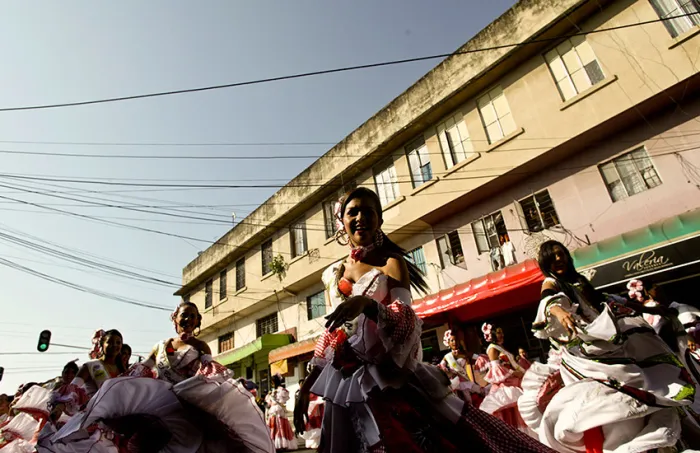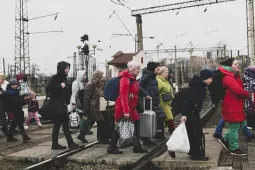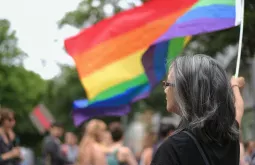Meeting Gabo on colombian streets

In January this year, I traveled to Colombia to spend two weeks in Barranquilla and Cartagena de Indias. I had heard magical things about both these Caribbean cities – all of which turned out to be true, including that Cartagena has “the most diaphanous sky in the world.” Only Gabriel Garcia Marquez could make the sky sound like lingerie. Lingerie spun from the “lavender evening light” that had enchanted him when he was a struggling young journalist with only a park bench for a bedroom.
Like many of the great cities of the world, Barranquilla and Cartagena are deeply unequal – the palm-thatched huts of the poor are only marginally smaller than the palm-thatched gazebos of the rich. Since I come from India, this was a sad but all too familiar sight.
But in January there was a celebratory feeling in the air in both cities. Barranquilla, a city that Garcia Marquez has praised for its “irreverence and iconoclasm,” was busy preparing for its carnival, an annual explosion of happiness that turns the streets into giant ruffles of music, dancing and booze. And Cartagena, whose restaurants have Parisian rates and portions, was in the middle of its lucrative tourist season.
Since the Nativity and New Year had just been celebrated, the walls of the barrios and markets were splashed withcolorful Feliz Navidad graffiti. I noticed that the bleaker the barrio, the brighter were its walls. Colombia’s rich like the minimalism of white stucco, but the minimalist poor prefer orange, blue, and purple. The decibel level of these colors was matched by the infectious carnival music blasting from massive black speakers placed aggressively on street corners by the boys of the barrio. My Colombian friends told me that every few years or so, the houses are repainted a different color, just to keep things lively. Now I understood why Jose Arcadio Buendia told the town magistrate to back off when the latter ordered the residents of Macondo to paint their home blue to celebrate Colombia’s independence from Spain. No one was going to order them around as far as their walls were concerned.
I loved the way I ran into Garcia Marquez stories on the almond tree-lined streets and in conversations. Several of the Colombian journalists on the FNPI program mentioned how their country had lost Panama because of US intervention. It was something that no Colombian seemed to have forgiven or forgotten. It reminded me of that surreal occurrence in The Autumn of the Patriarch where the Americans force a Latin dictator to give them the sea in payment of his debts. “They took away the Caribbean in April, Ambassador Ewing’s nautical engineers carried it off in numbered pieces to plant it far from the hurricanes in the blood-red dawns of Arizona.” In Colombia, as Gabo ever tires of saying, magical realism was all too real.
Feliz was being proclaimed not just on barrio walls but in more elite venues as well. Visitors were repeatedly told with a beaming pride that they were in the happiest country in the world. Gallup had just conducted a poll of fifty nations and Colombia had emerged right on top of its Global Barometer of Happiness, followed by Malaysia, Brazil and Saudi Arabia. In Barranquilla, there was merriment in the air. Across the city, preparations for the four-day February carnival were afoot. The carnival is a trophy vehicle for the city. With its African beats, native Indian dances and Spanish ruffles, it represents a mestizo-mulatto rainbow and sends out the message of racial integration, tolerance and inclusiveness. There is no doubt that the racial hybridity in Latin America is far more genuine and widespread than the strained and guilt-driven interaction I’ve witnessed in the United States. The carnival also acts as an important safety valve. The poor get a chance to let off steam and lampoon the rich and powerful – everyone from the aristocratic families and corrupt national politicians to Bill Clinton, who was described in one folk song as holding a glass of whiskey in one hand while being serviced by a “whiskey lady” below the table. Of course, the carnival also reflects the less flattering aspects of society, such as the entrenched notions of class and privilege. The most flagrant embodiment of this is the Carnival Queen: always a lily white and super-wealthy country club girl. This year, in a case of what came across as open favoritism, the girl chosen was the daughter of the president of Colombia’s ruling Conservative party. It would be wonderful if Barranquilla could have an indigenous or a black queen.
What I loved about the carnival fervor was the way that it touched every corner of the city. Although everyone, rich and poor, criticized it roundly for becoming more commercial with each passing year – “Now it’s all about TV cameras and big carriages and big balcaos and girls with big boobs,” one young girl told me angrily – no one can imagine life without it. It’s safe to say that the carnival is as integral to Barranquilla’s popular culture as is the Catholic Church.
One evening, I interviewed a group of wealthy youngsters to find out why they loved the carnival so much. The interview took place high up in the sky in a prosperous Alto Prado apartment where the setting sun bounced off long white sofas and a striking painting of Botero-sized apples. The previous night, I had watched this very group of youngsters whooping it up at a private party by the beach. They had danced expertly to the latest electronica from New York, cussed in fluent English and name-checked the boutiques of Barcelona, Miami and Paris. All of them had careers in expensive fields like fashion, film or industrial design. This formidably entitled tribe could afford to party almost anywhere in the world – New York, Shanghai, London. Charmingly, though, what really got them going was their city’s carnival.
Essentially, they said, ever since their newly baptized baby bodies had been thrust into ruffles, the carnival had been a central part of their lives. A delicious, wicked and utterly irreplaceable part. “I can get drunk at a different bar in a different town every Friday night if I wanted to,” said our host, Gabriella, named after the great Colombian writer, “but the carnival is different. It goes beyond culture. It is a reason for us to be proud. Proud to be from Barranquilla.”
The same sentiment was expressed at the other end of the social spectrum. One boiling afternoon, I visited La Central, a crowded and rundown barrio located on the fringes of Barranquilla. Despite its name, La Central it is anything but Central, but then, I also visited a fisherman’s village bravely called La Flores or The Flowers. Until very recently, La Central was described as the most dangerous barrio in Barranquilla and for years it has been a catchment area for displaced and refugee families, who English-speaking Colombians call, without malice, “superpoor people.” I’d never heard the word “superpoor” before and was struck by the phonetic and moral resonance it had with superpower.
Anyway, superpoor La Central is sandwiched between two cities: Barranquilla, which the happiness poll declared the happiest city in Colombia, and a smaller town called Soledad, which means solitude. Soledad features in The General in his Labyrinth as the little town where an ailing Simon Bolivar spends a month on his way to the river. Neither Barranquilla nor Soledad wanted to claim La Central, so for years it was a civic orphan. Being stuck being Happiness and Solitude only to be rejected by both is absurdly Marquesian. Only recently, after it officially became part of Soledad, did running water and electricity finally find their way there.
When we arrived, the barrio was in the middle of preparing for the carnival. Under the shade of a mango tree hung with the day’s washing, a group of dancers in flaming satin waited in anticipation. Suddenly, the seductive beat of Cumbia came crashing through the air and with a cry of joy the girls leapt into action. Within minutes, their crude satin gowns were transformed into frothy cyclones of red, gold and blue, the colors of the Colombian flag. From the vividly painted houses on either side, as closely set as teeth, neighbors appeared in the doorways to watch and cheer. A barefooted little girl set down a box of eggs and sat down carefully in the dust to watch. Under the dancers’ thin rubber slippers, the street was stony and unpaved, but they didn’t seem to notice or care. Shoulders and hips flashed and minced with a joyful precision. As the Cumbia surged to a crescendo, the group let out a high-pitched war cry: Viva Barranquilla! The neighborhood echoed their call. Over and over again. Viva Barranquilla! And for a brief and illusive moment, everything around looked a little less dismal.
Inside, in a room hung with a picture of the Virgin Mary, carnival masks and cobwebs, I met the old grandmother whose bony hands had sewn the gowns. She insisted she was 63 but seemed much older. She wore a blue frock, was toothless, bespectacled, bent and utterly dignified. Talking to her was like talking to Ursula Buendia, the matriarch of Macondo. Dignity is only gold dust that Garcia Marquez uses to redeem the most squalid conditions. Always, it is the women in his novels, dressed in strict mourning, who embody this quality that he first saw in his mother: “She had the character of a lioness, silent but fierce when faced with adversity, and a relationship with God that seemed more combative than submissive: two exemplary virtues that imbued her life with a confidence that never failed.” His women may or may not have big breasts but they always have big backbones.






